Acton Town tube station
| Acton Town | |
|---|---|
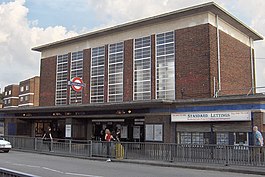 Station entrance | |
| Location | Acton |
| Local authority | London Borough of Ealing |
| Managed by | London Underground |
| Number of platforms | 4 |
| Accessible | Yes[note 1] |
| Fare zone | 3 |
| London Underground annual entry and exit | |
| 2019 | |
| 2020 | |
| 2021 | |
| 2022 | |
| 2023 | |
| Railway companies | |
| Original company | District Railway |
| Key dates | |
| 1 July 1879 | Opened asMill Hill Parkon the line to Ealing Broadway |
| 1 March 1910 | RenamedActon Town |
| 4 July 1932 | Piccadilly line services commenced |
| Listedstatus | |
| Listing grade | II |
| Entry number | 1263471[7] |
| Added to list | 17 May 1994[7] |
| Other information | |
| External links | |
| Coordinates | 51°30′10″N0°16′48″W/ 51.50278°N 0.28000°W |
Acton Townis aLondon Undergroundstation in the south-west corner ofActon,West London,in theLondon Borough of Ealing,close to the border with theLondon Borough of Hounslow.[8]The station is served by theDistrictandPiccadillylines and is inTravelcard Zone 3.[9]On the District line, it is betweenChiswick ParkandEaling Commonstations, and on the Piccadilly line it is betweenHammersmith(Turnham Greenin the early mornings and late evenings) and Ealing Common on theUxbridgebranch &South Ealingon theHeathrowbranch.[9] Acton Town station was opened as Mill Hill Park on 1 July 1879 by theDistrict Railway(DR, now the District line).[10]It remained as a terminus until on 1 May 1883 and 23 June 1903 the DR opened two branches from Acton Town toHounslow TownandPark Royal & Twyford Abbeyrespectively. On 4 July 1932 thePiccadilly linewas extended to Acton Town.District lineservices to both theHounslowandUxbridgebranches were withdrawn completely on 9 and 10 October 1964 after which operations were provided by thePiccadilly linealone.
The original brick-built station was built in 1879 and in February 1910 the station building was reconstructed.[10]On 1 March 1910 the station was given its present name.[10]In 1931 and 1932 the station was rebuilt again in preparation for transferring theUxbridgebranch service from theDistrict lineto thePiccadilly line.[10]The new station was designed byCharles Holden[10]in a modern European geometric style using brick, reinforced concrete and glass.[7]
Location
[edit]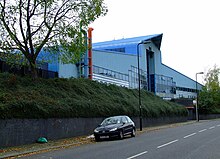
The station is at the junction of Gunnersbury Lane (A4000) andBollo Lane.[11]To the south-west of the station is the former Acton Works,[11]central overhaul and engineering works for the London Underground.[12]It is now home to theLondon Transport Museum's reserve collection of rail and road vehicles[11](as known as London Transport Museum Depot or Museum Depot). The museum depot is opened to the public on a number of weekends throughout the year.[13]To the north of the station is the District line'sEaling Common Depot.[11][14]
Frank Pick House is near the station, on Gunnersbury Lane.[11]It is named afterFrank Pick,theLondon Passenger Transport Board's chief executive.[15]It is home to one of the engineering departments of the London Underground.[15]
History
[edit]District line
[edit]Hounslow and Uxbridge branches
[edit]Acton Town station was opened as Mill Hill Park on 1 July 1879[16]by theDistrict Railway(DR, now the District line) on its extension from Turnham Green to Ealing Broadway.[10][17]On 1 May 1883 the DR opened a branch from Acton Town to the now defunctHounslow Town station,which developed into the Heathrow branch.[17]On 23 June 1903 the DR tracks extended north of Acton Town to a new station atPark Royal & Twyford Abbeywhich became the first of the Underground's surface lines to use electric traction instead of steam with the Acton Town – Ealing Common section also electrified.[17]The existing deep tube lines, (City and South London Railway,Waterloo & City Railway(now Waterloo & City line) andCentral London Railway) had always been electrically powered.[18][19][20]Services on the Hounslow branch (now the Heathrow branch) and to Central London were electrified on 13 June 1905 and 1 July 1905 respectively.[17]
South Acton branch
[edit]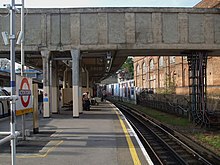
On 13 June 1905, a passenger service began on the short branch toSouth Acton.[17][21]A short fifth platform for the single car train of the South Acton branch was provided to the north of the eastbound island platform.[21]At first the service ran toHounslow Westand toUxbridgebut it was later reduced to a shuttle between Acton Town and South Acton on 15 February 1932.[17][21][note 2]The South Acton branch was closed on 28 February 1959 due to low usage;[17]its platform at Acton Town has not been removed and is still visible. Much of the branch remains including a bridge support on the south side ofBollo Lane.[21]In the picture, the area behind the hoarding in the background is the location of the former branch platform (Platform 5) which was only ever very short, two carriages at most. Part of a dismantled bridge where the shuttle crossed Bollo Lane remains near the entrance toActon Works[22]
Piccadilly line
[edit]On 4 July 1932, the Piccadilly line was extended west from its original terminus at Hammersmith and shared the route with the District line to Ealing Common.[10][14]From Ealing Common to South Harrow, the District line was replaced by the Piccadilly line, and from that date, District line trains from Acton Town ran only either to Hounslow West or to Ealing Broadway.[14]On 9 January 1933 Piccadilly line trains, sharing with the District line, began servingNorthfieldson the Hounslow branch, and their service was extended to Hounslow West on 13 March 1933 but Piccadilly line trains did not call at South Ealing until 1935.[14]District line services on the Hounslow branch were withdrawn on 9 and 10 October 1964 after which operations were provided by the Piccadilly line alone.[17]
Station building
[edit]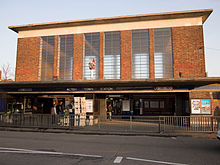
Track layout | |||||||||||||||||||||||||||||||||||||||||||||||||||||||||||||||||||||||||||||||||||||||||||||||||||||||||||||||||||||||||||||||||||||||||||||||||||||||||||||||||||
|---|---|---|---|---|---|---|---|---|---|---|---|---|---|---|---|---|---|---|---|---|---|---|---|---|---|---|---|---|---|---|---|---|---|---|---|---|---|---|---|---|---|---|---|---|---|---|---|---|---|---|---|---|---|---|---|---|---|---|---|---|---|---|---|---|---|---|---|---|---|---|---|---|---|---|---|---|---|---|---|---|---|---|---|---|---|---|---|---|---|---|---|---|---|---|---|---|---|---|---|---|---|---|---|---|---|---|---|---|---|---|---|---|---|---|---|---|---|---|---|---|---|---|---|---|---|---|---|---|---|---|---|---|---|---|---|---|---|---|---|---|---|---|---|---|---|---|---|---|---|---|---|---|---|---|---|---|---|---|---|---|---|---|---|
| |||||||||||||||||||||||||||||||||||||||||||||||||||||||||||||||||||||||||||||||||||||||||||||||||||||||||||||||||||||||||||||||||||||||||||||||||||||||||||||||||||
The original brick-built station was built in 1879.[10]In February 1910 the station building was reconstructed and on 1 March 1910 the station was given its present name.[10]In 1931 and 1932 the station was rebuilt again in preparation for transferring the Uxbridge branch service from the District line to the Piccadilly line.[10]The new station was designed byCharles Holden[10]in a modern European geometric style using brick, reinforced concrete[7]and glass.
As other stations Holden designed,[23][note 3]Acton Town station features a tall block-like ticket hall rising above a low horizontal structure housing the station offices and shops.[7]The ticket hall has a projecting London Underground roundel sign over a canopy,[10]the brick walls of the ticket hall are punctuated with panels ofclerestorywindows[7]and the structure is capped with a flat concrete slab roof. From the ticket hall enclosed stairs descend to the platforms under integral concrete canopies on paired piers in alternating broad and narrow bay formation.[10]A part of the narrow bays is infilled by kiosks, integral poster boards, roundel signs and fixed seating.[10]The platforms are linked by a secondary bridge at the southern end.[10]Reinforced concrete platform canopies replaced the original timber canopies.[10]Since 17 May 1994, the station has been a Grade IIListed building.[7]
The stated reason for why it should be listed was:
Reinforced concrete post and lintel construction with red brick infill, some load-bearing. Symmetrical almost square and double-height ticket hall flanked by kiosks on bridge, from which parade of shops descends to Bollo Lane with secondary entrance under stepped boxed lighting to the rear. Ticket hall gives on to complex access area with open frame construction, whence enclosed stairs descend to platforms under integral concrete. canopies - incorporating clerestory - on paired piers in alternating broad and narrow bay formation. The narrow bays part infilled by kiosks, integral poster boards, roundel signs and fixed seating. The platforms are linked by a secondary bridge at the southern end. All the frontage shops have their original bronzed glazing, particularly elaborate in the taller frontages to Bollo Lane and in the side passage. All shopdoors original save that to single shop east of station. The station windows metal with strong horizontal emphasis in their glazing bars. Ticket hall has projecting roundel sign over canopy, and three double-height paired windows to street frontage with similar windows at upper level to rear. Exposed concrete frame to ceiling, rendered upper walls with brown tiling below. Original tiled floors. Included as an important example of Holden's mature work for an interchange station.[7]
Services and connections
[edit]Services
[edit]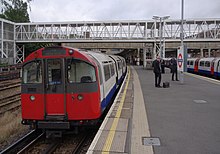
Between Acton Town andHammersmith,District line trains serve all stations, but Piccadilly line trains run non-stop to Hammersmith except for calling atTurnham Greenat the start and end of the day.[9]The run between Acton Town and Hammersmith spans nearly three miles – the longest distance between stops on the Piccadilly line.[25][26]West of Acton Town, District line trains go viaEaling CommontoEaling Broadwayand Piccadilly line trains run either viaSouth EalingtoHeathrow,or via Ealing Common to Uxbridge.[9]
District line
[edit]The typical off-peak service in trains per hour (tph) is:
There is also a morning service every day from Acton Town (Ealing Broadway on Saturdays) toEdgware Roadand a late evening service from Edgware Road to Ealing Broadway on Sundays only.[17]
Piccadilly line
[edit]Train frequencies vary throughout the day, but generally operate every 2–5 minutes eastbound,[29]Off-Peak = 3 tph to Uxbridge and 3 tph to Rayners Lane, Peak = 6 tph to Uxbridge and 6 tph to Rayners Lane, and every 2–7 minutes westbound to Heathrow Terminal 2 & 3 and Terminal 5 or via the Heathrow Terminal 4 loop.[30]Since 16 December 2016, Acton Town is also served by Night Tube trains betweenCockfostersandHeathrow Terminal 5.[31]
During occasional closures on the District line, the Piccadilly line provides additional services to serve destinations on the District line such as Ealing Broadway.[14]This is done either by diverting some trains bound for Rayners Lane and Uxbridge, or as a shuttle from Acton Town.[14]Also, Piccadilly line trains may also run on the District line tracks between Hammersmith and Acton Town to serve the District line stations with no platforms on the Piccadilly line,[14]namely Ravenscourt Park, Stamford Brook, Turnham Green and Chiswick Park.[note 4]
Connections
[edit]London Busesroutes70,E3and night routeN11serve the station.[32]
Incidents
[edit]On 25 March 1993, a woman namedJean Bradley was stabbed to deathby a man after leaving Acton Town tube station. The notorious murder still remains unsolved.[33]
On Tuesday, 1 February 2022, a large fire occurred at the Autocar Centre,[34]a garage adjacent to the now-abandoned Platform 5 is, which subsequently caused the evacuation of the station and "severe delays" to theDistrict lineandPiccadilly line.[35]10 fire engines and 70 firefighters[36]were sent to the scene after being called at 5:10 PM and stayed there until late at night, bringing the fire under control. The cause of the fire is not yet known, but will be investigated by the LFB.[36]Since the fire, witnesses in the area have described the roof as burned and partially caved in, though the damage to the abandoned Platform 5 itself is unknown.
Gallery
[edit]-
A row of London Underground D78 stock trains in old painted livery at Acton Depot viewed from Gunnersbury lane
-
Electric locomotive at Acton Town. This shows an example of the class of 20electric locomotivesintroduced by theMetropolitan Railwayfrom 1922 onwards. The example shown here is No. 12,Sarah Siddons.
Notes and references
[edit]Notes
[edit]- ^Page 1: Acton Town – Lift access between street and platform[1]
- ^The branch was also known as the "There and back while the kettle boils" branch because of the short distance and quick turnaround at South Acton.[17]
- ^Sudbury Town,the first station to be rebuilt in 1931, formed a template for many of the other new stations that followed, including Acton Town: a tall rectangular brick box with a flat concrete slab roof and panels of vertical glazing to allow light into the interior. Holden called them his "brick boxes with concrete lids".[24]The Sudbury Town pattern was reproduced with adaptations atAlperton,Eastcote,Northfields,Oakwood,Rayners Lane,Sudbury HillandTurnpike Lane.However, Alperton station is not a listed building.
- ^Ravenscourt Park has four platforms, two platforms for each line[17]but the Piccadilly line platforms are rarely used.[14]Stamford Brook has three platforms, one island and one side platform.[17]The island platform is used by westbound District and Piccadilly line services while the side platform is used by eastbound District line services only.[17]Note that the Piccadilly line platform is also not frequently used.[14]Piccadilly line services call at Turnham Green in the early mornings and late evenings only.[9][14]
References
[edit]- ^"Avoiding stairs Tube guide"(PDF).Transport for London.May 2020. Archived fromthe original(PDF)on 27 November 2020.
- ^"Station Usage Data"(XLSX).Usage Statistics for London Stations, 2019.Transport for London.23 September 2020.Archivedfrom the original on 9 November 2020.Retrieved9 November2020.
- ^"Station Usage Data"(XLSX).Usage Statistics for London Stations, 2020.Transport for London.16 April 2021.Retrieved1 January2022.
- ^"Station Usage Data"(XLSX).Usage Statistics for London Stations, 2021.Transport for London.12 July 2022.Retrieved7 September2022.
- ^"Station Usage Data"(XLSX).Usage Statistics for London Stations, 2022.Transport for London.4 October 2023.Retrieved10 October2023.
- ^"Station Usage Data"(XLSX).Usage Statistics for London Stations, 2023.Transport for London.8 August 2024.Retrieved16 September2024.
- ^abcdefghHistoric England."Acton Town London Regional Transport Underground Station (1263471)".National Heritage List for England.Retrieved23 August2016.
- ^"Initial Consultation on Possible Residents' Parking Schemes – Acton Town and Chiswick Main line station areas"(PDF).Hounslow Council.Archived fromthe original(PDF)on 23 June 2015.Retrieved23 June2015.
- ^abcdeStandard Tube Map(PDF)(Map). Not to scale.Transport for London.April 2024.Archived(PDF)from the original on 28 May 2024.Retrieved3 June2024.
- ^abcdefghijklmnopHistoric England."Detailed Result:Acton Town Station (508142)".Research records (formerly PastScape).Retrieved12 April2015.
- ^abcde"Acton Town Tube Station".Google Maps.Retrieved14 April2015.
- ^"Research Guide No 18: Transport for London and Predecessors Non-Operational Premises Post 1933"(PDF).TfL Corporate Archives Research Guides.Transport for London.18 March 2013. Archived fromthe original(PDF)on 17 October 2015.Retrieved15 April2015.
- ^"What's On – Museum Depot".London Transport Museum.Archivedfrom the original on 11 April 2015.Retrieved22 March2015.
- ^abcdefghijFeather, Clive."Piccadilly line".Clive's Underground Line Guides.Archivedfrom the original on 3 April 2015.Retrieved22 March2015.
- ^ab"Frank Pick House, Acton".flickr.8 October 2011.Archivedfrom the original on 18 April 2015.Retrieved14 April2015.
- ^Glinert 2012.
- ^abcdefghijklmnoFeather, Clive."District line".Clive's Underground Line Guides.Archivedfrom the original on 3 April 2015.Retrieved22 March2015.
- ^Greathead 1896,p. 7.
- ^Feather, Clive."Waterloo & City line".Clive's Underground Line Guides.Archivedfrom the original on 12 April 2015.Retrieved12 April2015.
- ^Day & Reed 2008,p. 56.
- ^abcd"District line – South Acton to Acton Town".Abandoned Stations.Archivedfrom the original on 14 April 2015.Retrieved22 March2015.
- ^"Geograph:: Bollo Lane viaduct, W3 © Phillip Perry".www.geograph.org.uk.Retrieved20 February2022.
- ^"16 London Underground Stations Listed at Grade II".English Heritage. 26 July 2011. Archived fromthe originalon 4 January 2015.
- ^Orsini 2010.
- ^"Stations that it takes the longest to travel between".Tube Facts and Figures.Geofftech. Archived fromthe originalon 3 April 2015.Retrieved22 March2015.
- ^Spittles, David (28 April 2014)."Map your house hunting future: new homes hotspots along the Piccadilly line".Evening Standard.London.Archivedfrom the original on 11 April 2015.Retrieved30 April2014.
- ^"District line timetable: From Acton Town Underground Station to Chiswick Park Underground Station".Transport for London.Retrieved22 March2015.
- ^"District line timetable: From Acton Town Underground Station to Ealing Common Underground Station".Transport for London.Retrieved22 March2015.
- ^"Piccadilly line timetable: From Acton Town Underground Station to Arnos Grove Underground Station".Transport for London.Retrieved22 March2015.
- ^"Piccadilly line timetable: From Acton Town Underground Station to South Ealing Underground Station".Transport for London.Retrieved22 March2015.
- ^Standard Night Tube Map(PDF)(Map). Transport for London. June 2023.Archived(PDF)from the original on 22 March 2024.Retrieved3 June2024.
- ^"Buses from Acton Central"(PDF).TfL.15 July 2023.Retrieved14 July2023.
- ^"Murder of successful businesswoman stabbed 8 times with 'butchers knife' in random attack remains unsolved".MyLondon.9 July 2022.Retrieved17 December2022.
- ^"Severe Tube disruption as 70 firefighters tackle huge blaze at Acton Town station".LBC.Retrieved1 February2022.
- ^"Acton Town fire: 10 fire engines and 70 firefighters dispatched to tackle blaze".Sky News.Retrieved1 February2022.
- ^ab"Car Garage Fire - Acton".London Fire Brigade.
Further reading
[edit]- Butt, R.V.J. (1995).The Directory of Railway Stations.Patrick Stephens Ltd.ISBN1-85260-508-1.
- Day, John R.; Reed, John (2008) [1963].The Story of London's Underground(10th ed.). Harrow: Capital Transport.ISBN978-1-85414-316-7.
- Glinert, Ed (2012).The London Compendium.Penguin UK.ISBN978-0-71819-203-7.
- Greathead, James Henry (1896)."The City and South London Railway".with some Remarks Upon Subaqueous Tunnelling by Shield and Compressed Air. With an abstract of the discussion upon the paper.London: The Institution of Civil Engineers.Retrieved15 April2015.
- Jowett, A. (2000).Jowett's Nationalised Railway Atlas.Atlantic Publishing.ISBN0-906899-99-0.
- Orsini, Fiona (2010).Underground Journeys: Charles Holden's designs for London Transport(PDF).V&A+RIBAArchitecture Partnership. Archived fromthe original(PDF)on 14 March 2012.Retrieved22 March2015.
External links
[edit]- "Acton Town".Photographic Archive.London Transport Museum.Archivedfrom the original on 12 February 2014.
| Preceding station | Following station | |||
|---|---|---|---|---|
| Ealing Common towardsEaling Broadway
|
District line | Chiswick Park towardsUpminsterorHigh Street Kensington
| ||
| Ealing Common towardsUxbridgeorRayners Lane
|
Piccadilly line | Turnham Green Early morning and late evening service only towardsCockfostersorArnos Grove
| ||
| Ealing Common | Piccadilly line | Hammersmith towardsCockfostersorArnos Grove
| ||
| South Ealing | Piccadilly line | Turnham Green Early mornings and late evenings service only towardsCockfostersorArnos Grove
| ||
| South Ealing | Piccadilly line | Hammersmith towardsCockfostersorArnos Grove
| ||
| Preceding station | Following station | |||
| Terminus | District line South Acton branch
(1905–1959) |
South Acton Terminus
| ||
| South Ealing towardsHounslow TownorHounslow West
|
District line Hounslow branch
(1883–1964) |
Chiswick Park towardsUpminsterorHigh Street Kensington
| ||
- Rail transport stations in London fare zone 3
- District line stations
- Piccadilly line stations
- London Underground Night Tube stations
- Tube stations in the London Borough of Ealing
- Former Metropolitan District Railway stations
- Railway stations in Great Britain opened in 1879
- Charles Holden railway stations
- Art Deco architecture in London
- Grade II listed buildings in the London Borough of Ealing
- Grade II listed railway stations
- Acton, London



